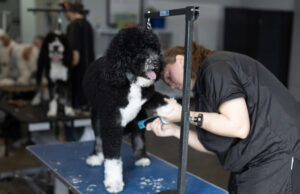
If you have an urge to create discord and angst, here’s one way to do it: Go to a dog behavior conference or seminar and boldly state, “I think we should discuss the meaning of the term ‘prey drive,’ and decide whether or not we should continue to use it.” Then, make a dash for the exit before it gets ugly.
To most people in the dog world, the term “prey drive” refers to a dog’s eagerness or desire to work hard, especially if the work involves anything related to chasing and capturing prey. It’s a trait that makes many dogs successful in the world of canine sports. The term is often used by people whose dogs participate in agility or f ly ball as well as by those whose dogs work in search and rescue or law enforcement.
Additionally, it has become increasingly popular when discussing dogs with various behavioral issues, typically issues related to chasing (cars, squirrels, runners, bikes, children) and the resulting difficulty in teaching them to come or to pay attention in general around any of these distractions.
Sometimes “prey drive” is used in a positive sense, as in, “She’s excited about working because she has a high prey drive. I love her enthusiasm and motivation, and the prey drive gives her such great endurance too.” It can also be used in a negative way, as in, “I can never let her off-leash in areas that aren’t fenced in. She has such high prey drive that she’ll chase anything. I can’t trust her to come back or stay out of trouble.”
So, though prey drive is commonly used in the dog world, many people dislike it. From an ethological perspective, it doesn’t make sense. If you ask an ethologist (someone who studies the behavior of animals in their natural environments) who doesn’t happen to be involved in that world — and the vast majority of them aren’t — what they think of the term, they will look at you quizzically and then criticize it on the grounds that it’s nonsensical.
To ethologists, the word “drive” refers to an unknown and variable internal state that explains why an animal’s response to a stimulus is not identical every time the animal is exposed to it. For example, at times, a dog may charge after a tennis ball with gleaming eyes and an over-the-top bouncy enthusiasm, while at other times, that same dog may lazily lope after the ball or even ignore it, though the stimulus (the thrown ball) is the same. What’s different is the dog’s interest in or motivation to chase it. “Drive” is the term used to explain that difference, which ethologists consider to be a difference in internal states, perhaps based on neurological or physiological variables over time.
Fluctuation in an animal’s drive doesn’t just affect predatory behavior. It also influences how eager a dog is to eat, drink and engage in sexual behavior, or any other type of behavior for that matter. Yet, we don’t talk about food drive, water drive or potential-mating-partner drive. We say that a dog is hungry or food-motivated (or a chowhound); that the dog is thirsty; or, in the case of females, that she is sexually receptive. To be fair, the term “sex drive” is used to describe the state of having an interest in mating — referring typically (but not always) to males — but we don’t say female drive or male drive.
Even in the way that many people use it, prey drive lacks precision. Does it mean a drive to run, to chase, to catch something, to bite it, to kill it or any combination of these? Is it all related to predatory behavior, and if so, why is the term “prey drive” used, rather than “predatory drive”?
Words and phrases that express precise concepts are indispensable for communication, and the more specific we can be, the better. However, the inexactness of language can make it a challenge to convey precise meanings. For example, because English is short on words that describe emotional nuance, people say things such as, “Do you like him or do you like him?”
Some people feel that the word “drive” doesn’t actually explain an animal’s behavior. In one sense, it’s an oversimplification to say that an animal is behaving a certain way because of an internal state or a change in that internal state. We know that an animal’s motivation changes over time and that different members of the same species behave differently in the presence of identical stimuli, but we don’t often know why. So, the term is more descriptive and less explanatory than it purports to be. A label such as “prey drive” is essentially a shorthand way to describe what we don’t understand since we don’t have complete knowledge of dogs’ internal states and their effect on behavior.
Another problem with prey drive is that it is often used in an attempt to explain a dog’s unwanted behavior toward other dogs and even people,neither of which are normally objects of canine predatory focus. We’ve all heard people dismiss a dog’s inappropriate, undesirable and sometimes even aggressive behavior with the comment that the dog has a high prey drive. It sounds so much nicer than saying that the dog has little impulse control, a far-from-ideal temperament or has not been the beneficiary of sufficient training.
Criticisms of the phrase may be a predictable result of the fact that often, when terms are appropriated from other fields, they are used in a slightly different way. The current meaning of terms in our field may not match their original use, which can cause confusion and thus, a tendency to consider that the way the terms are being used is “wrong.”
Overall, the terminology employed to describe canine behavior is messy, perhaps in part because dog behavior encompasses a number of disciplines, among them ethology, evolution, physiology, neurobiology, sociology, psychology, learning theory and animal husbandry.
For example, the words “operant conditioning” can mean something different to those involved in the dog world than they do to those who study learning theory. Many dog trainers use the phrase with its original meaning in mind: the modification of behavior through the use of positive reinforcement, negative reinforcement, positive punishment and negative punishment. Others use it as a synonym for positive reinforcement alone; when these people say they train using operant conditioning, they mean that they use positive reinforcement. However, in the field of learning theory, positive reinforcement is only one part of operant conditioning. Similarly, the concept of drive, which comes from the academic discipline of ethology, has come to mean something different, though related, in the world of dogs.
It’s wise to acknowledge that terms have to be considered in context. Would it be better if no such confusion ever arose and multiple meanings didn’t exist? Sure, there would be advantages, but the reality is that languages change, as do fields of study and their associated terminology.
Cultures vary in the way they accept and integrate shifting meanings in the language used to describe the world around them. On one extreme, the French are well known for their strong national pride in the stability of their language, and the great importance they place on maintaining le bon usage (the correct usage) and resisting change, particularly Anglicisms. At the other extreme is the surfer culture with its enthusiastic proliferation of new words and phrases such as “tubular,” “hang ten,” “in the soup” and “goofy footed.” Americans generally accept new words and phrases easily, accounting for the rapid spread of “going postal,” “cougar,” “to be plutoed” and, most recently, “Tebowing.”
So where does the dog community stand collectively in our tolerance for changes in language, new terminology and the appropriation of terms from other fields into our own lexicon?
Many people love new terms. They enjoy referring to “predatory drift” and “reactivity” (the term “aggression” used to suffice), and they happily accept “prey drive.” Others would greatly prefer to hear that a dog is enthusiasticabout agility or fly ball, or that the dog is motivated to run the course, take the jumps or retrieve a ball.
What’s important is that we understand one another. The reality is that when most people talk about prey drive in dogs, they are referring to the enthusiasm and strong motivation that makes dogs sharp on the course, eager to participate and reliably give their all in competition or in play. I suspect that the term “prey drive” is here to stay, and I sure hope that the joy of dogs who possess a lot of it also remains with us forever.
Copyright © Karen B. London
[author] [author_image timthumb=’on’]https://wagntails.net/wp-content/uploads/2020/02/author-image.png[/author_image] [author_info]About the Author Christine Fox, APDT, CTDI and a Pet Sitters International member, is the founder of Wag ‘N’ Tails Dog Activity Center with two locations in Michigan. She has been involved with many pet dog trainer certification initiatives, all based on learning techniques that involve humane practices and the latest in scientific research. Christine also raised a service dog for Paws With a Cause and plans to train her newest pup in therapy work. Through her work with dogs and their parents, Christine has developed many happy and healthy relationships with both humans and dogs in the community.[/author_info] [/author]








